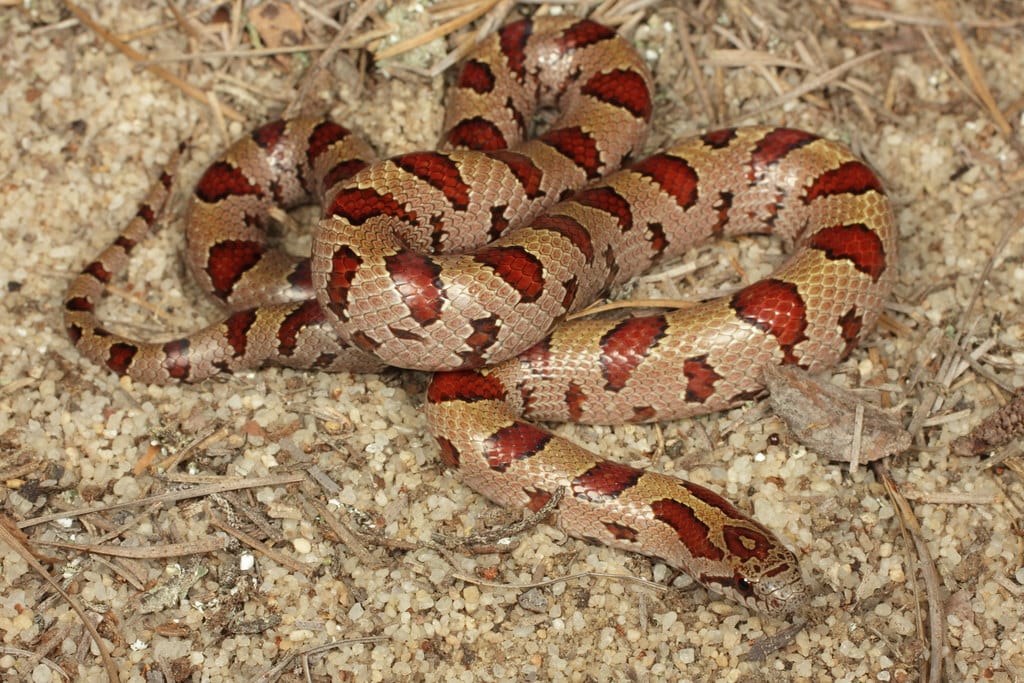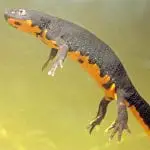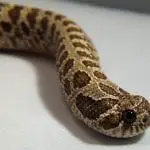Scientific Facts
| Common Name: | Mole Kingsnake, Blotched Kingsnake, Brown Kingsnake, House Snake, Mole Catcher, Mole Snake, Ground Snake |
| Scientific Name: | Lampropeltis Calligaster Rhombomaculata |
| Life Span: | |
| Length: | 30 to 40 inches |
| Clutch Size: | 10 to 12 eggs |
| Habitat: | Pine forests, open woodlands, and fields |
| Country of Origin: | United States |
Physical Description
Adult Mole Kingsnakes come in olive-brown or yellowish color, with some small reddish-brown blotches towards its back. This pattern usually alternates with smaller blotches that are visible on the sides. Every blotch features a narrow, black border. They also have a belly that is yellowish yellowish-brown in color, with some brown spots. Juvenile snakes look similar to the adults, though their blotches are dark-edged, and clear. As they continue to age, the blotches become more indistinct.
The average size of adult Mole Kingsnakes is 30 to 40 inches, while the longest snake recorded is 47 inches. Some old snakes are almost solid brown in color. The neck of these snakes is indistinct. They are also known for the light light-colored Y-shaped pattern at the back of their head and neck. At times, there is a dark line through their eyes. They have smooth scales, with 21 to 23 dorsal scale rows located at their midbody.
Taxonomy
Mole Kingsnakes belong to the Lampropeltis Calligaster species. Other three related subspecies are also available. When taxonomists speak of this group collectively, they usually refer to it as the yellow-bellied group of Kingsnakes, though hobbyists separate the Mole Kingsnakes from the others.
Even though these snakes are collected by hobbyists, they are not really as popular as other members of the Kingsnake group, or the other species like the milksnakes and tricolored kingsnakes. Even though these subspecies have differences in characteristics, they share one similarity. They all share the dark blotches on every subspecies, which are brightest and broadest anteriorly, and solid-back posteriorly. These blotches may be vertebrally broken, forming two lines composed of two dorsolateral spots instead of just a single saddle.
Related Subspecies
Mole Kingsnakes belong to a species of Kingsnake, the Lampropeltis Calligaster. It comes with three subspecies. When taxonomists speak collectively of this species as a group, they usually refer to them as the yellow-bellied group of kingsnakes, though hobbyists separate mole kings steadfastly from the prairie kingsnakes.
Even though some snake hobbyists keep Mole Kingsnakes, they are generally not as popular as the other members of the usual kingsnake group as well as the many species and subspecies of milk snake or tricolored kingsnakes.
The Lampropeltis Calligaster family has two of the most popular large snakes in both central and eastern North America. The “mole kingsnake” name says it all. The two subspecies are the well-known South Florida mole kingsnake and the northern mole kingsnake.
Another member of their group is the prairie kingsnake. Despite the fact that they are secretive, they are not as persistent of a burrower as their relatives. There is not enough information about the home life of this species.
Even though all three subspecies feature characteristic differences, they have at least one similarity. The dorsal spots and blotches on each of the subspecies are brightest and broadest in their anterior parts and solid-black in their posterior parts. These blotches may be broken in a vertebral way, thus creating two lines of dorsolateral spots instead of just a single saddle.
Habitat and Range
Mole Kingsnakes are found in soft soil areas, including cultivated or abandoned fields. They are known to be adept burrowers and are encountered rarely above ground except after heavy rains and at night. They usually do not dig holes but tend to burrow through loose soil.
When it comes to the range of other subspecies, the known range actually varies. Prairie kingsnakes, for example, have a well-defined range, which is also similar to the northern, eastern, and western range boundaries of the range of the northern mole kingsnakes. Still, the southeastern range boundaries are still poorly defined. The same goes for the entire range where South Florida mole kingsnakes are found.
A broad expanse with suitable habitat extends from the southernmost part of the range of the northern mole Kingsnakes, including Alabama and Georgia, to the territory in the Florida Panhandle. On top of that, a distance of several hundred miles is also found in between the recognized range of the northern subspecies in Florida. At the same time, the currently recognized local mole kingsnakes of South Florida are found on the central peninsula.
What can be referred to as unclear as of the moment is whether these mole kingsnakes are absent within these expenses, or they have not yet been found there yet. These snakes can be so secretive that they may not have been discovered to this point.
As a matter of fact, some years ago, a northern mole kingsnake was discovered in the garden of a resident in Alachua County. In terms of distance, this is around 150 miles southeaster of the panhandle territory. Some biologists think that such a snake was an escapee, though the real reason for its existence is something that may continue to be unknown.
If that snake was a natural resident of the range, then there might be a question as to whether how far south the snake came from. This further introduces a debate as to the location of the real line of demarcation between South Florida and the northern mole kingsnake subspecies may be.
Interesting Facts
Here are some interesting facts about Mole Kingsnake:
- These snakes are observed to be secretive, spending a lot of time underground. They are also found commonly crossing roads at night time.
- These Kingsnakes are also known as Blotched Kingsnake, Brown Kingsnake, House Snake, Mole Catcher, Mole Snake, or Ground Snake.
- It has a name “Kingsnake” because of the fact that other snakes, including species that are venomous, are their main food source. They also eat other food items, including lizards, rodents, worms, insects, and slugs.
- They are typically confused with the common Brown Snake when they are seen in the field. The Mole Kingsnake, however, is usually copper, reddish, or olive olive-brown in color, with a head that is larger than that of the usual Brown Snake. They also have a ventral surface that is yellowish in color, with some orange blotches.
- Their genus “Lampropeltis” comes from the Greek word “Lampros”, which means “radiant”, and the Latin word “Pelta”, which means “small shield”. These words describe the small-scaled, shiny Kingsnakes.
- Their specific name “Calligaster” comes from the Greek word “Kallos”, which means “beautiful”, and “Gaster”, which means “stomach”. These are also descriptions to of the ventral pattern among juveniles.
Behavior
Mole Kingsnakes are seen rarely in the wild due to their preference for living underground. They are also most active at night. Due to their being reclusive, their life cycle and biology is are not studied or well-known. These snakes are usually seen after heavy rains, immediately after an agricultural field is plowed. They are also seen crossing roads at night, making them victims of being hit by motor vehicles. These snakes are non-venomous. They are constrictors that love to spend most of their time in burrows, preferring the shallow ones.
Housing
Few mole kingsnakes reach over 4 feet in length, which means that they can be kept inside a terrarium of a cage of 20 gallons or less. It is very important to make sure that the cage is tightly covered. Other cage furniture items can also be added, including a hide box, and limbs.
As with the substrate, cypress mulch, aspen shavings, paper towels or newspapers are among the common options. Aspen and cypress mulch offer a burrowing location, as well as visual barriers for these highly secretive snakes. Newspapers and paper towels, on the other hand, are safe for the snakes. You can feed your snakes without worrying about fibers or wood chips being ingested accidentally.
Hatchling and adult mole kingsnakes thrive when their terrarium is situated near room temperature. The use of an under tank heater can further offer a temperature gradient. The warmer end of the cage should have a temperature of about 84 to 88 degrees, while the cooler end should also be around 74 to 76 degrees Fahrenheit. There is no requirement of special lighting for these snakes.
Feeding and Diet
Feeding The feeding of this species is quite simple. Mole Kingsnakes feed on small mammals, lizards, insects, invertebrates, as well as other snakes. In captivity, most sub-adults and adult snakes accept frozen and thawed mice. With this in mind, freshwater should always be present inside the terrarium.
Reproduction
These snakes usually breed from June to July. The female snakes usually lay a clutch of 15 to 17 eggs in underground locations. Mole Kingsnakes typically mate in late spring or early summer. Male snakes look for female snakes using pheromone trails. After the process of mating is completed, female snakes select suitable nesting sites where they deposit their clutches of about 10 to 12 eggs on the average. After the eggs are laid, the females simply disperse, leaving their offspring behind. The eggs usually hatch in late summer to early fall after completing a gestation period of around two months. The baby snakes become completely independent in about 10 days after their hatching.
Breeding
Mole kingsnakes may be bred readily. The snakes should be kept at their best health condition, parasite-free, and well-taken care of. In order to prepare them for breeding, it is recommended to maintain a natural photoperiod, and then cooling the snakes in darkness, mimicking the hibernation period, at a temperature of about 48 to 56 degrees for a period of 90 days within the winter months.
After the snakes are removed from the hibernaculum, they can be introduced once again to room temperature. When feeding them, give them smaller pieces first in order not to put pressure on their digestive system. After they defecate, you can start feeding them normally again. During or right after the first post-hibernation shed, put the male and female snakes together in one place.
Once copulation is complete, prepare an egg nesting box, usually a plastic shoebox with a hole cut in the cover. Fill it with moist sphagnum moss. As the female lays her laying date, it is best to remove the water dish, as she might end up laying her eggs there.
Conservation and Threats
Despite the fact that nobody can report with certainty, these snakes are thought to be somewhat abundant. For this reason, they are not currently listed as either vulnerable or threatened in any of their state range. Due to their reclusiveness, they are well-protected from predation as well as abuse by humans.
Where to Get Mole Kingsnakes
As mentioned, these snakes are not as common as the other subspecies of kingsnakes. Still, a growing interest in these snakes has been observed, as seen in the increase in the number of breeders taking an interest in these snakes. For this reason, you can find these snakes from local breeders, online sources, as well as specialty reptile pet stores.
FAQ Section
Is Moke Kingsnake poisonous?
Mole kingsnakes are usually seen right after heavy rains, surfacing after an agricultural field is plowed, or crossing roads at night. They are non-venomous constrictors who love spending most of their time in burrows.
What do Moke Kingsnakes eat?
These snakes eat a wide range of prey, including lizards, small mammals, and birds, as well as other snakes.
Where do Mole Kingsnakes live?
Mole Kingsnakes live in the Southeast and Mid-Atlantic regions of the United States. They usually live in pine forests, open woodlands, and fields, both cultivated and abandoned. These snakes burrow, and thus attracted to sandy and well-drained soil.
What eats Mole Kingsnakes?
Among the predators of Mole Kingsnakes include raccoons, birds of prey, as well as other snakes. To what extent this is possible is currently unknown.
Are Mole Kingsnakes endangered?
Even though there is no certainty to of their status, Mole Kingsnakes are observed to be relatively abundant. As such, they are not currently listed as threatened or vulnerable in any areas within their range. Due to their reclusiveness, they are protected appropriately from predation.



